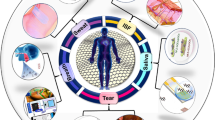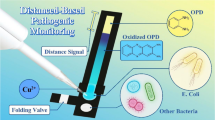Abstract
The amounts of uric acid (UA) in non-invasive biological samples, such as saliva, are critical for diagnosis and therapy of gout, hyperuricemia, Lesch–Nyhan syndrome, and several other diseases. Here, disposable UA biosensors were fabricated with the screen printing technique on the substrate of flexible PET. The working electrode was modified with carbon nanotubes followed by uricase for UA detection with excellent selectivity. The biosensor showed good electrocatalytic activity toward UA with high sensitivity, low detection limit, and wide linear range, which covers the full range of UA levels in human saliva. We demonstrate that UA can be directly detected in human saliva with the biosensor and the experimental data were consistent with the clinical analysis. This study indicated that the non-invasive biosensor is an attractive and possible approach for the monitoring of salivary UA.

A disposable uric acid biosensor modified with carbon nanotubes followed by uricase was fabricated on flexible PET and applied for the monitoring of salivary uric acid in human saliva







Similar content being viewed by others
References
Marshall WJ. Clinical chemistry. 4th ed. Missouri: MOSBY; 2000.
Liao CZ, Mak C, Zhang M, Chan HLW, Yan F. Flexible organic electrochemical transistors for highly selective enzyme biosensors and used for saliva testing. Adv Mater. 2015;27:676–81.
Puig JG, Torres RJ, De Miguel E, Sánchez A, Bailén R, Banegas JR. Uric acid excretion in healthy subjects: a nomogram to assess the mechanisms underlying purine metabolic disorders. Metabolism. 2012;61:512–8.
Zoppini G, Targher G, Chonhol M, Ortalda V, Abaterusso C, Pivhiri I, et al. Serum uric acid levels and incident chronic kidney disease in patients with type 2 diabetes and preserved kidney function. Diabetes Care. 2012;35:99–104.
Sharaf El Din UAA, Salem MM, Abdulazim DO. Uric acid in the pathogenesis of metabolic, renal, and cardiovascular diseases: a review. J Adv Res. 2017;8:537–48.
Bel’skaya LV, Sarf EA, Kosenok VK. Age and gender characteristics of the biochemical composition of saliva: correlations with the composition of blood plasma. J Oral Biol Craniofac Res. 2020;10:59–65.
Hamzah HH. Spectrophotometric determination of uric acid in urine based–enzymatic method uricase with 4–aminodiphenylamine diazonium sulfate (Variamine Blue RT Salt). J Anal Bioanal Tech. 2013;S7:011.
Yue GZ, Li SY, Liu W, Ding F, Zou P, Wang XX, et al. Ratiometric fluorescence based on silver clusters and N, Fe doped carbon dots for determination of H2O2 and UA: N, Fe doped carbon dots as mimetic peroxidase. Sensors Actuators B Chem. 2019;287:408–15.
Ezoddin M, Adlnasab L, Afshari KA, Karimi MA. Ultrasonically formation of supramolecular based ultrasound energy assisted solidification of floating organic drop microextraction for preconcentration of methadone in human plasma and saliva samples prior to gas chromatography–mass spectrometry. Ultrason Sonochem. 2019;50:182–7.
Westley C, Xu Y, Thilaganathan B, Carnell AJ, Turner NJ, Goodacre R. Absolute quantification of uric acid in human urine using surface enhanced Raman scattering with the standard addition method. Anal Chem. 2017;89:2472–7.
Pang X, Li FS, Huang SQ, Yang ZQ, Mo Q, Huang L, et al. Electrostatically mediated layer–by–layer assembly of nitrogen–doped graphene/PDDA/gold nanoparticle composites for electrochemical detection of uric acid. Anal Bioanal Chem. 2020;412:669–80.
Wang YY, Liu X, Lu ZW, Liu T, Zhao LJ, Ding F, et al. Molecularly imprinted polydopamine modified with nickel nanoparticles wrapped with carbon: fabrication, characterization and electrochemical detection of uric acid. Microchim Acta. 2019;186:414.
Shi YT, Wang J, Li SM, Yan B, Xu H, Zhang K, et al. The enhanced photo–electrochemical detection of uric acid on Au nanoparticles modified glassy carbon electrode. Nanoscale Res Lett. 2017;12:455.
Huang HP, Yue YF, Chen ZZ, Chen YA, Wu SZ, Liao JS, et al. Electrochemical sensor based on a nanocomposite prepared from TmPO4 and graphene oxide for simultaneous voltammetric detection of ascorbic acid, dopamine and uric acid. Microchim Acta. 2019;186:189.
Guan WH, Duan XX, Reed MA. Highly specific and sensitive non–enzymatic determination of uric acid in serum and urine by extended gate field effect transistor sensors. Biosens Bioelectron. 2014;51:225–31.
Cinti S, Talarico D, Palleschi G, Moscone D, Arduini F. Novel reagentless paper–based screen–printed electrochemical sensor to detect phosphate. Anal Chim Acta. 2016;919:78–84.
Barton J, García MBG, Santos DH, Fanjul-Bolado P, Ribotti A, McCaul M, et al. Screen–printed electrodes for environmental monitoring of heavy metal ions: a review. Microchim Acta. 2016;183:503–17.
Arduini F, Micheli L, Moscone D, Palleschi G, Piermarini S, Ricci F, et al. Electrochemical biosensors based on nanomodified screen–printed electrodes: recent applications in clinical analysis. TrAC – Trends Anal Chem. 2016;79:114–26.
Cinti S, Arduini F. Graphene–based screen–printed electrochemical (bio)sensors and their applications: efforts and criticisms. Biosens Bioelectron. 2017;89:107–22.
Abellán-Llobregat A, Jeerapan I, Bandodkar A, Vidal L, Canals A, Wang J, et al. A stretchable and screen–printed electrochemical sensor for glucose determination in human perspiration. Biosens Bioelectron. 2017;91:885–91.
Jia LC, Li YK, Yan DX. Flexible and efficient electromagnetic interference shielding materials from ground tire rubber. Carbon. 2017;121:267–73.
Wen L, Li F, Cheng HM. Carbon nanotubes and graphene for flexible electrochemical energy storage: from materials to devices. Adv Mater. 2016;28:4306–37.
Liu YZ, Li GR, Guo Y, Ying YL, Peng XS. Flexible and binder–free bierarchical porous carbon film for supercapacitor electrodes derived from MOFs/CNT. ACS Appl Mater Interfaces. 2017;9:14043–50.
Navazesh M. Methods for collecting saliva. Ann N Y Acad Sci 1993.
Li SQ, Lin PF, Zhao LP, Wang C, Liu DY, Liu FM, et al. The room temperature gas sensor based on Polyaniline@flower–like WO3 nanocomposites and flexible PET substrate for NH3 detection. Sensors Actuators B Chem. 2018;259:505–13.
Kumar L, Rawal I, Kaur A, Annapoorni S. Flexible room temperature ammonia sensor based on polyaniline. Sensors Actuators B Chem. 2017;240:408–16.
Yaqoob U, Uddin ASMI, Chung GS. A high–performance flexible NO2 sensor based on WO3 NPs decorated on MWCNTs and RGO hybrids on PI/PET substrates. Sensors Actuators B Chem. 2016;224:738–46.
Gupta R, Singh B. Enhancement of electrical conductivity and magnetic properties of bimetallic Schiff base complex on grafting to MWCNTs. J Mater Sci Mater Electron. 2019;30:11888–906.
Bassoukou IH, Nicolau J, Santos MT. Saliva flow rate, buffer capacity, and pH of autistic individuals. Clin Oral Investig. 2009;13:23–7.
Huang Y, Bu LJ, Wang W, Qin XL, Li Z, Huang Z, et al. One–pot preparation of uricase–poly(thiophene–3–boronic acid)–Pt nano composites for high–performance amperometric biosensing of uric acid. Sensors Actuators B Chem. 2013;177:116–23.
Fukuda T, Muguruma H, Iwasa H, Tanaka T, Hiratsuka A, Shimizu T, et al. Electrochemical determination of uric acid in urine and serum with uricase/carbon nanotube/carboxymethylcellulose electrode. Anal Biochem. 2020;590:113533.
Piermarini S, Migliorelli D, Volpe G, Massoud R, Pierantozzi A, Cortese C, et al. Uricase biosensor based on a screen–printed electrode modified with Prussian blue for detection of uric acid in human blood serum. Sensors Actuators B Chem. 2013;179:170–4.
Verma S, Choudhary J, Singh KP, Chandra P, Singh SP. Uricase grafted nanoconducting matrix based electrochemical biosensor for ultrafast uric acid detection in human serum samples. Int J Biol Macromol. 2019;130:333–41.
Liu Y, Yuan M, Liu LL, Guo R. A facile electrochemical uricase biosensor designed from gold/amino acid nanocomposites. Sensors Actuators B Chem. 2013;176:592–7.
Chen D, Wang Q, Jin J, Wu P, Wang H, Yu S, et al. Low–potential detection of endogenous and physiological uric acid at uricase–thioninesingle–walled carbon nanotube modified electrodes. Anal Chem. 2010;82:2448–55.
Jain S, Verma S, Singh SP, Sharma SN. An electrochemical biosensor based on novel butylamine capped CZTS nanoparticles immobilized by uricase for uric acid detection. Biosens Bioelectron. 2019;127:135–41.
da Cruz FS, Paula F d S, Franco DL, dos Santos WTP, Ferreira LF. Electrochemical detection of uric acid using graphite screen–printed electrodes modified with Prussian blue/poly(4–aminosalicylic acid)/uricase. J Electroanal Chem. 2017;806:172–9.
Shetty SR, Babu S, Kumari S, Prasad R, Bhat S, Fazil KA. Salivary ascorbic acid levels in betel quid chewers: a biochemical study. South Asian J Cancer. 2013;2:142–4.
Shibasaki K, Kimura M, Ikarashi R, Yamaguchi A, Watanabe T. Uric acid concentration in saliva and its changes with the patients receiving treatment for hyperuricemia. Metabolomics. 2012;8:484–91.
Ngamchuea K, Batchelor-McAuley C, Compton RG. Understanding electroanalytical measurements in authentic human saliva leading to the detection of salivary uric acid. Sensors Actuators, B Chem. 2018;262:404–10.
Funding
This work was financially supported by the National Natural Science Foundation of China (31741051, 21874077), Key R&D Projects of Jiangsu Province (BE 2019690), the Basic Science Research Program of Nantong City (JC2018066), the Science and Technology of R&D fund of Nantong City (XG202008-02), Qing Lan Project of Jiangsu Province, and the Jiangsu Overseas Visiting Scholar Program for University Prominent Young and Middle-Aged Teachers and Presidents.
Author information
Authors and Affiliations
Corresponding authors
Ethics declarations
Conflict of interest
The authors declare that they have no conflicts of interest.
Research involving human participants and/or animals
All procedures performed in studies involving human participants were in accordance with the ethical standards of the institutional and/or national research committee and with the 1964 Helsinki declaration and its later amendments or comparable ethical standards. The collection of samples was approved by the Ethics Committee of the Affiliated Hospital of Nantong University, and the experiments on human biologic samples were approved by the Ethics Committee of Nantong University.
Informed consent
Informed consent was obtained from all individual participants included in the study.
Additional information
Publisher’s note
Springer Nature remains neutral with regard to jurisdictional claims in published maps and institutional affiliations.
Rights and permissions
About this article
Cite this article
Shi, W., Li, J., Wu, J. et al. An electrochemical biosensor based on multi-wall carbon nanotube–modified screen-printed electrode immobilized by uricase for the detection of salivary uric acid. Anal Bioanal Chem 412, 7275–7283 (2020). https://doi.org/10.1007/s00216-020-02860-w
Received:
Revised:
Accepted:
Published:
Issue Date:
DOI: https://doi.org/10.1007/s00216-020-02860-w




